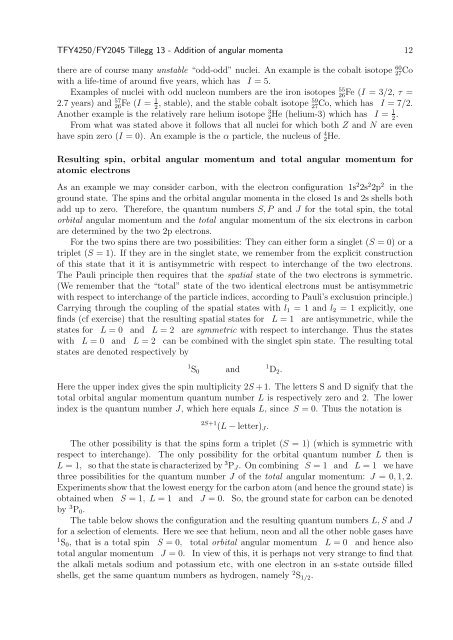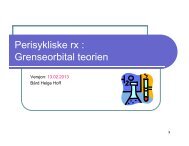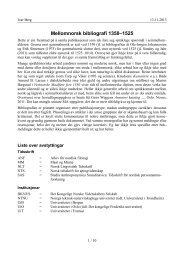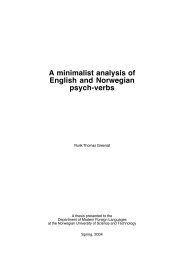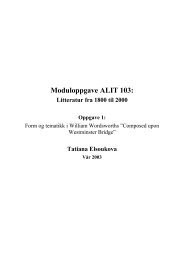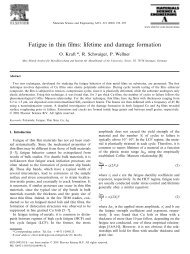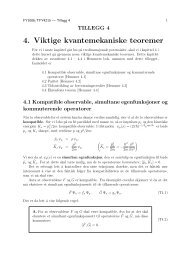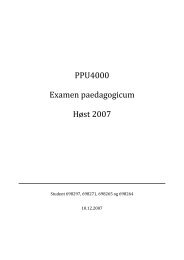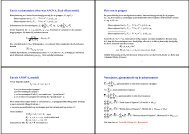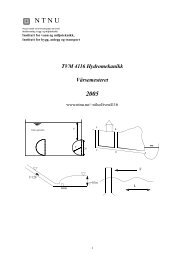Create successful ePaper yourself
Turn your PDF publications into a flip-book with our unique Google optimized e-Paper software.
TFY4250/FY2045 Tillegg <strong>13</strong> - <strong>Addition</strong> <strong>of</strong> <strong>angular</strong> <strong>momenta</strong> 12<br />
there are <strong>of</strong> course many unstable “odd-odd” nuclei. An example is the cobalt isotope 60<br />
27Co<br />
with a life-time <strong>of</strong> around five years, which has I = 5.<br />
Examples <strong>of</strong> nuclei with odd nucleon numbers are the iron isotopes 55<br />
26Fe (I = 3/2, τ =<br />
2.7 years) and 57<br />
26Fe (I = 1 59<br />
, stable), and the stable cobalt isotope<br />
2 27Co, which has I = 7/2.<br />
Another example is the relatively rare helium isotope 3 2He (helium-3) which has I = 1.<br />
2<br />
From what was stated above it follows that all nuclei for which both Z and N are even<br />
have spin zero (I = 0). An example is the α particle, the nucleus <strong>of</strong> 4 2He.<br />
Resulting spin, orbital <strong>angular</strong> momentum and total <strong>angular</strong> momentum for<br />
atomic electrons<br />
As an example we may consider carbon, with the electron configuration 1s 2 2s 2 2p 2 in the<br />
ground state. The spins and the orbital <strong>angular</strong> <strong>momenta</strong> in the closed 1s and 2s shells both<br />
add up to zero. Therefore, the quantum numbers S, P and J for the total spin, the total<br />
orbital <strong>angular</strong> momentum and the total <strong>angular</strong> momentum <strong>of</strong> the six electrons in carbon<br />
are determined by the two 2p electrons.<br />
For the two spins there are two possibilities: They can either form a singlet (S = 0) or a<br />
triplet (S = 1). If they are in the singlet state, we remember from the explicit construction<br />
<strong>of</strong> this state that it it is antisymmetric with respect to interchange <strong>of</strong> the two electrons.<br />
The Pauli principle then requires that the spatial state <strong>of</strong> the two electrons is symmetric.<br />
(We remember that the “total” state <strong>of</strong> the two identical electrons must be antisymmetric<br />
with respect to interchange <strong>of</strong> the particle indices, according to Pauli’s exclusuion principle.)<br />
Carrying through the coupling <strong>of</strong> the spatial states with l 1 = 1 and l 2 = 1 explicitly, one<br />
finds (cf exercise) that the resulting spatial states for L = 1 are antisymmetric, while the<br />
states for L = 0 and L = 2 are symmetric with respect to interchange. Thus the states<br />
with L = 0 and L = 2 can be combined with the singlet spin state. The resulting total<br />
states are denoted respectively by<br />
1 S 0 and<br />
1 D 2 .<br />
Here the upper index gives the spin multiplicity 2S + 1. The letters S and D signify that the<br />
total orbital <strong>angular</strong> momentum quantum number L is respectively zero and 2. The lower<br />
index is the quantum number J, which here equals L, since S = 0. Thus the notation is<br />
2S+1 (L − letter) J .<br />
The other possibility is that the spins form a triplet (S = 1) (which is symmetric with<br />
respect to interchange). The only possibility for the orbital quantum number L then is<br />
L = 1, so that the state is characterized by 3 P J . On combining S = 1 and L = 1 we have<br />
three possibilities for the quantum number J <strong>of</strong> the total <strong>angular</strong> momentum: J = 0, 1, 2.<br />
Experiments show that the lowest energy for the carbon atom (and hence the ground state) is<br />
obtained when S = 1, L = 1 and J = 0. So, the ground state for carbon can be denoted<br />
by 3 P 0 .<br />
The table below shows the configuration and the resulting quantum numbers L, S and J<br />
for a selection <strong>of</strong> elements. Here we see that helium, neon and all the other noble gases have<br />
1 S 0 , that is a total spin S = 0, total orbital <strong>angular</strong> momentum L = 0 and hence also<br />
total <strong>angular</strong> momentum J = 0. In view <strong>of</strong> this, it is perhaps not very strange to find that<br />
the alkali metals sodium and potassium etc, with one electron in an s-state outside filled<br />
shells, get the same quantum numbers as hydrogen, namely 2 S 1/2 .


